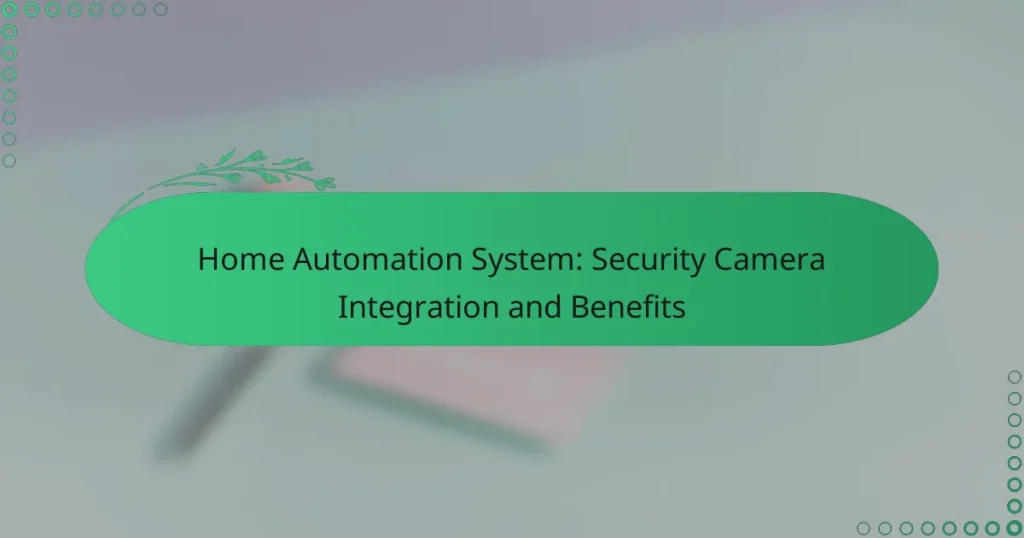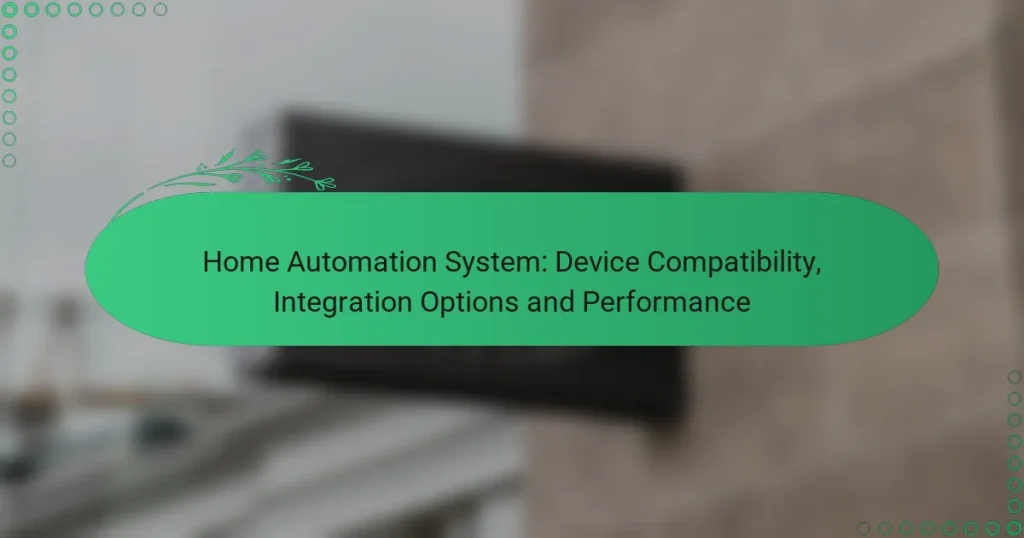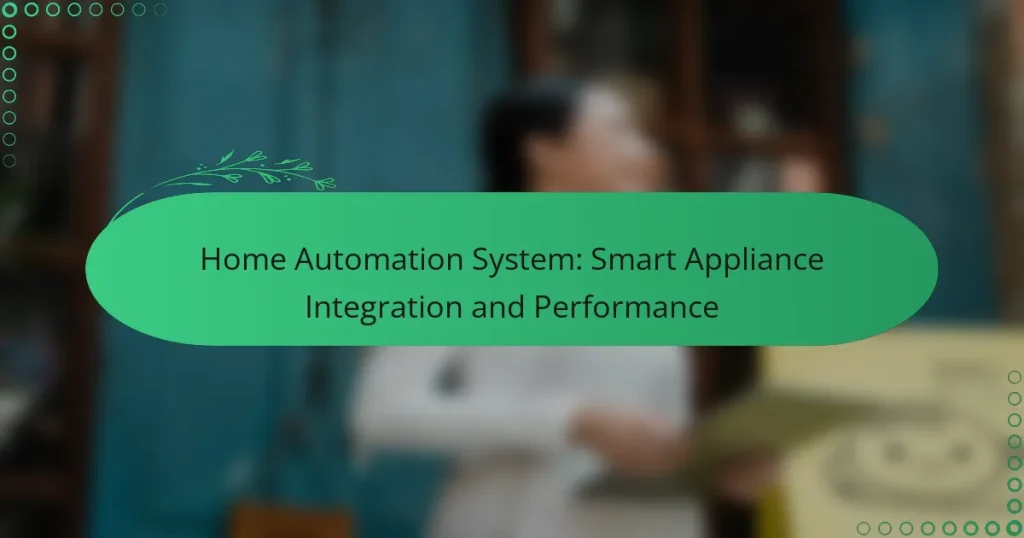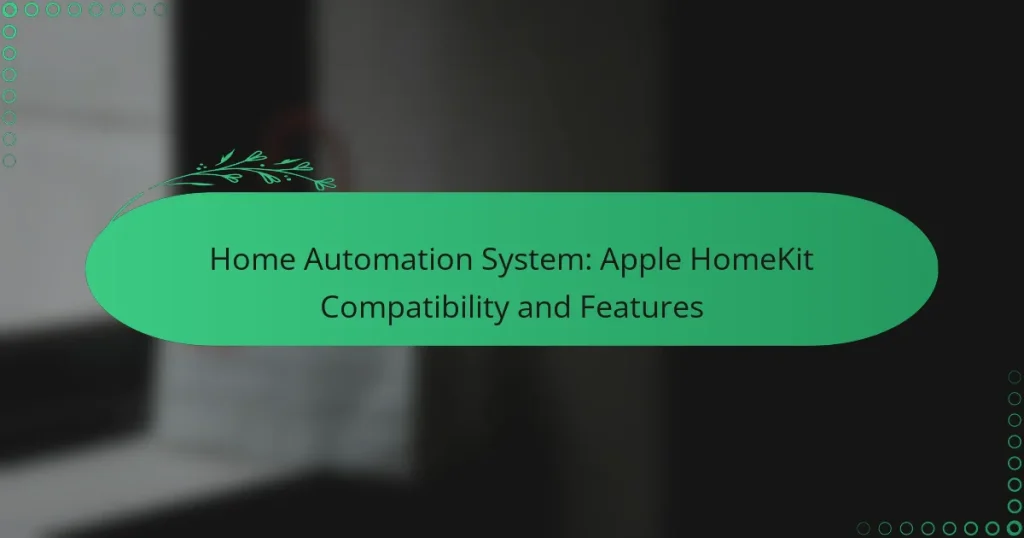When selecting a home automation system, compatibility is key to ensuring a seamless integration of your devices. Popular options like Amazon Alexa, Google Home, and Apple HomeKit offer diverse features and support for various smart devices. It’s important to evaluate your existing technology and preferences to choose the system that best fits your needs.
Home Automation System: Device Compatibility, Integration Options and Performance
Home Automation System: Smart Appliance Integration and Performance
Home Automation System: Apple HomeKit Compatibility and Features
What are the best home automation systems for compatibility?
The best home automation systems for compatibility include Amazon Alexa, Google Home, Apple HomeKit, Samsung SmartThings, and Wink Hub. Each system offers unique features and supports various devices, making it essential to choose one that aligns with your existing technology and preferences.
Amazon Alexa compatibility
Amazon Alexa is compatible with a wide range of smart home devices, including lights, thermostats, cameras, and locks. It supports over 100,000 products from various manufacturers, allowing users to create a cohesive smart home environment.
When selecting devices for Alexa, ensure they are labeled as “Works with Alexa.” This guarantees seamless integration and control through voice commands. Popular compatible brands include Philips Hue, Ring, and Ecobee.
Google Home compatibility
Google Home offers compatibility with numerous smart devices, similar to Alexa. It supports products from brands like Nest, Philips Hue, and TP-Link, allowing for easy voice control and automation.
To maximize compatibility, look for devices that explicitly state “Works with Google Assistant.” This ensures that you can manage your smart home through Google Home’s voice commands and routines.
Apple HomeKit compatibility
Apple HomeKit is designed for users within the Apple ecosystem, providing compatibility with a range of devices that prioritize security and privacy. HomeKit-enabled devices can be controlled via the Home app on iOS devices.
When choosing HomeKit products, check for the “Works with Apple HomeKit” label. Popular options include smart bulbs from LIFX and smart locks from August. Keep in mind that HomeKit may have fewer device options compared to Alexa and Google Home.
Samsung SmartThings compatibility
Samsung SmartThings is a versatile platform that supports a wide array of smart home devices, including sensors, cameras, and appliances. It is compatible with products from various brands, making it a flexible choice for users.
To ensure compatibility, look for devices that support Zigbee or Z-Wave protocols, as these are commonly used with SmartThings. This platform allows for extensive automation options and integration with other systems like Alexa and Google Home.
Wink Hub compatibility
Wink Hub provides compatibility with a diverse range of smart devices, including those that use Zigbee, Z-Wave, and Wi-Fi. This makes it a good option for users with mixed-device ecosystems.
When selecting devices for Wink, ensure they are compatible with the Wink Hub. Popular brands include Philips Hue and August. However, note that Wink has faced challenges in maintaining its service, which could affect long-term usability.
How to choose a compatible home automation system?
Choosing a compatible home automation system involves assessing the devices you want to integrate, ensuring they work seamlessly together. Focus on compatibility with existing devices, ecosystem integration, and the user interface for a smooth experience.
Assess device compatibility
Start by identifying the devices you currently own and those you plan to purchase. Check if they support common communication protocols like Wi-Fi, Zigbee, or Z-Wave. Compatibility can vary significantly, so prioritize systems that can connect with a wide range of devices.
Make a list of your essential devices, such as smart lights, thermostats, and security cameras. Verify their compatibility with your chosen home automation system by consulting manufacturer specifications or user reviews.
Consider ecosystem integration
Evaluate how well the home automation system integrates with existing ecosystems, such as Google Home, Amazon Alexa, or Apple HomeKit. A well-integrated system allows for streamlined control and automation across devices, enhancing user experience.
Look for systems that support multiple ecosystems if you have devices from different brands. This flexibility can save you from being locked into a single manufacturer and allows for easier future upgrades.
Evaluate user interface
The user interface is crucial for managing your home automation system effectively. A clear, intuitive interface can significantly enhance your experience, making it easier to control devices and set up automation routines.
Consider whether the system offers mobile apps, web interfaces, or voice control options. Test the interface if possible, as a user-friendly design can save time and reduce frustration when managing your smart home.
What devices are commonly compatible with home automation systems?
Home automation systems typically support a variety of devices that enhance convenience and security. Commonly compatible devices include smart lights, smart thermostats, smart locks, and smart cameras, each offering unique functionalities that can be integrated into a cohesive system.
Smart lights
Smart lights allow users to control their lighting remotely through apps or voice commands. They can be programmed to turn on or off at specific times, change colors, or adjust brightness levels based on user preferences.
When selecting smart lights, consider compatibility with your home automation hub and the type of connection (Wi-Fi, Zigbee, or Z-Wave). Popular brands include Philips Hue and LIFX, which offer a range of options for different needs.
Smart thermostats
Smart thermostats enable efficient temperature control and energy savings by learning user habits and preferences. They can be adjusted remotely and often provide energy usage reports to help optimize heating and cooling.
Look for models that integrate seamlessly with your existing HVAC system and are compatible with your home automation platform. Popular choices include the Nest Learning Thermostat and Ecobee SmartThermostat.
Smart locks
Smart locks enhance home security by allowing keyless entry through mobile apps or biometric recognition. They can be programmed to grant temporary access to guests and provide alerts when doors are locked or unlocked.
When choosing smart locks, ensure they fit your door type and check for compatibility with your home automation system. Brands like August and Schlage offer reliable options with various features.
Smart cameras
Smart cameras provide real-time surveillance and can send alerts when motion is detected. They often feature two-way audio and night vision, making them versatile for home security.
Consider the camera’s resolution, field of view, and storage options when selecting a model. Popular options include the Arlo Pro and Ring cameras, which integrate well with many home automation systems.
What are the limitations of home automation system compatibility?
Home automation system compatibility is often limited by brand-specific features and protocol incompatibility. These limitations can hinder the seamless integration of devices from different manufacturers, affecting functionality and user experience.
Brand-specific limitations
Many home automation systems are designed to work optimally with devices from the same brand. For instance, a smart home hub from one manufacturer may not support devices from another brand, leading to a fragmented experience. This can result in limited functionality, as certain features may only be available when using compatible devices.
To avoid these issues, consider choosing devices from the same brand or those explicitly labeled as compatible with your existing system. Researching user reviews and compatibility lists can also help identify potential limitations before making a purchase.
Protocol incompatibility
Home automation devices often use different communication protocols, such as Zigbee, Z-Wave, or Wi-Fi. Protocol incompatibility can prevent devices from communicating effectively, leading to a disjointed smart home experience. For example, a Zigbee device will not connect to a Z-Wave hub without a compatible bridge.
When selecting devices, check the communication protocols they support and ensure they align with your existing system. Using a universal hub that supports multiple protocols can help mitigate these issues, allowing for greater flexibility in device selection.
How to troubleshoot compatibility issues in home automation?
Troubleshooting compatibility issues in home automation involves checking device specifications, ensuring proper network settings, and updating software. Start by verifying that all devices are compatible with your chosen home automation platform and that they are correctly configured to communicate with each other.
Check firmware updates
Keeping firmware updated is crucial for resolving compatibility issues in home automation systems. Manufacturers regularly release updates that enhance functionality, fix bugs, and improve device interoperability. Check the manufacturer’s website or the device’s app for the latest firmware versions.
To update firmware, connect the device to your home network and follow the instructions provided in the user manual or app. This process typically takes a few minutes and can significantly enhance performance and compatibility with other devices.
Be cautious when updating firmware; ensure that the device remains powered during the process to avoid bricking it. If issues persist after an update, consider rolling back to a previous version if that option is available.



